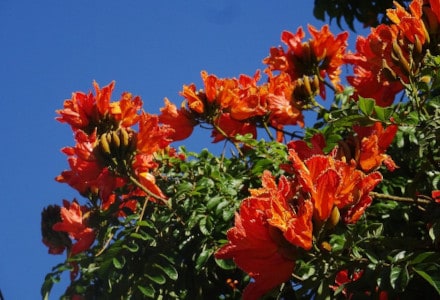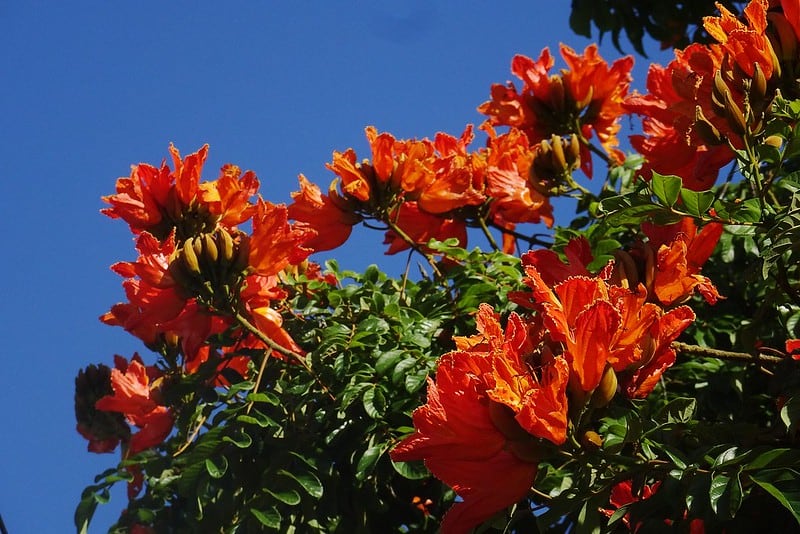African Tulip Tree Facts
- This magnificent variety of tree most frequently goes by the simultaneously informative yet deceptive common name of the African Tulip Tree. The marvel of Nature and evolution also represents the only known member of its genus, making it monotypic.
- Professionals, such as researching botanists typically refer to the plant by its formal scientific name, though. That, though, remains a bit of a tongue-twister for those outside the profession. Its official name is that of the Spathodea campanulata.
- The noted and highly respected French naturalist, Ambrose Marie Francois Joseph Palisot, made the first known recognition of it as a separate and distinct species. This scientifically noteworthy accomplishment further occurred in the year 1787.
- Unfortunately, though, this awesome species now qualifies as a highly invasive species in the minds of many people. That holds true due to the fact that it now appears in many non-native regions of the world, directly due to the actions of mankind.
- That’s because, in many areas of the globe, it’s frequently used as an ornamental plant. This usage occurs primarily, yet by no means exclusively, in the tropical regions of the world. Where imported, it’s also toxic to some of the locally present insect species.
- The African Tulip Tree appears to be maintaining a population base that’s sufficient and stable. That’s partly due to its popularity as an ornamental species, however. Its population also seems to be locally prevalent and healthy in its native range.
- Due to these factors, the IUCN currently has no listing for the species on its Red List. It nonetheless could be considered to be in at least some danger, as most species today. Its greatest potential threats most likely include habitat loss and climate change.
Related Articles
African Tulip Tree Physical Description
The visually distinctive African Tulip Tree easily merits admiration and respect. It does so, however, for several reasons, not just its sheer beauty. That’s because, in addition to that visual appeal, the natural wonder also qualifies as a respectably-sized variety of tree.
Individuals specimens further vary significantly in size, even in identical environmental conditions, though. Its height therefore varies from between 23 – 82 ft (7 – 25 m). It also tends to have a strongly vertical form, instead of developing a broad crown, as some species.
Its foliage also impresses those who encounter it, because of their natural appearance. These begin as a bronze color, when young. As they mature, however, this color changes to a shiny green. Each of its numerous leaves also possesses a strongly veined nature.
It’s the gorgeous blooms of the African Tulip Tree, though, that garner the most attention. These also serve as the source of the common name, given their purported resemblance to tulips. Each tree also tends to produce these marvelous blooms in great numbers.
Each develops in flamboyant, vibrant colors. Colors vary somewhat from tree to tree, yet shades of bright reddish-orange predomiate. Each stunning flower further manifests five elongated petals, and averages between 3.1 – 5.9 in (8 – 15 cm) in terms of overall length.
- Kingdom: Plantae
- Phylum: Spermatophyta
- Class: Angiosperm
- Order: Lamiales
- Family: Bignoniaceae
- Genus: Spathodea
- Species: S. campanulata
African Tulip Tree Distribution, Habitat, and Ecology
The very name of the amazing African Tulip Tree provides a clear indication of its general region of origin. As that name indicates, this product of ages of evolution evolved as native to a portion of the continent now known as Africa, known for its natural splendor.
Within that greater region, however, it seems to only appear natively only in roughly half the continent. More specifically, the tree apparently evolved as native to what now forms the countries of Angola, Ghana, Ethiopia, Sudan, Kenya, Uganda, Tanzanai, and Zambia.
Though it’s proven moderately adaptible in human efforts to use it as an ornamental species, in the wild it displays specific habitat preferences. In that specific native range, the impressive Angiosperm almost exclusively inhabits regions of dry forests.
The remarkable Lamiale also serves several important roles in its native ecosystem. The shape of its open flowers holds quantities of water, making them an important source of it for many birds. Its nectar also remains popular with several species of hummingbirds.
Each specimen further provides yet another valuable service to its local ecosytem. This involved the nature of its wood itself. That’s due to the fact that this feature of the tree develops as relatively soft. It therefore provides a nesting site for hole-dwelling birds.
Sadly, though, the beautiful but controversial African Tulip Tree also represents a harmful species in parts of the world where it’s been imported. These inclue areas such as Queensland, Australia, Fiji, Sri Lanka, Papua new Guinea, and Hawaii, in the United States.
Species Sharing Its Range
Check out our other articles on 3 Terrific Freshwater Turtles, Reef Manta Ray, Blood Falls, Platypus, Chinese Giant Salamander, Nicobar Pigeon, Spiny Bush Viper


